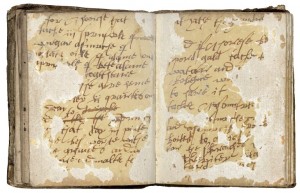I’ve decided to name my SIF blog after an essentially forgotten technology of the Renaissance. Having spent the summer somewhat schizophrenically split between preparations for a fellowship in digital pedagogy and straining my eyes over early modern manuscripts and four hundred year old books, I have been thinking a lot about how the communication revolution that we are living through, excited by and struggling with, compares with the equally powerful communicative revolutions of the Renaissance. The classical way of framing these transformations is the story of how the printing press enabled the explosive growth of “print culture,” which is now rapidly retreating before the dawning of the digital age. There are a lot of problematic and useful aspects of this line of thought, and I hope to use this blog in part as a forum for thinking them through. But today, I want to start with something much simpler, modest, and concrete, the table-book.
Table-books were composed of specially manufactured paper, coated with gesso (a plaster) and glue so that the pages could be written on with pen, or more commonly a stylus, and then erased. Though they survive only in small numbers, table-books appear to have been in relatively common use in early modern England, by a wide variety of users. Many extant table-books were bound inside almanacs, books marketed towards merchants and relatively popular audiences. Some were ornately bound, presented as gifts to the nobility, even to Queen Elizabeth herself. Scholars and students would likely have used them quite often in the course of their studies.

Writing tables with a kalender for xxiiii. yeeres, with sundry necessarie rules (London, 1604), Folger Shakespeare Library (STC 24284), used by permission of the Folger Shakespeare Library under a Creative Commons Attribution-ShareAlike 4.0 International License.
Table-books were technologically important in part because of their portability — when used with a stylus, they allowed a writer to make jottings and notes in much more causal settings than was possible using a quill and inkhorn. Moreover, they facilitated the pedagogical principles of commonplacing and memory-building that were at the heart of renaissance education. Table-books were used as a place for note-taking while reading, allowing students to quickly and relatively indiscriminately collect extracts, notes, and aphorisms (“commonplaces”), as they read. These would later be transferred to paper and ink when the student recopied them into their commonplace book. This may seem redundant, but the act of copying twice served important intellectual purposes. In the first instance, it reinforced memory, taking double advantage of the memory-enhancing qualities of writing something down. Second, it gave students the chance to sharpen their discrimination by deciding which of their initial notes warranted secondary, and more permanent, entry into a commonplace book, and — ideally at least — into the mind the student.
Like the technologies we will be working with in SIF, table-books sat at the intersection of broad social and economic forces, pedagogy, and technological change. In the early modern era, these included not only the much-celebrated advent of the printing press, but a much less renowned, but perhaps equally significant set of changes spawned by the economics of cheaper paper. Paper, at least as much as the printed letters sometimes applied to it, greatly facilitated the spread of literacy in early modern England, enabling a history of writing to develop alongside the better-understood and much more storied history of reading. In -the renaissance, the intersection of the new cultures of paper and ink would form a distinctive pedagogy grounded in the reading, extraction, and re-writing of classical texts, and to the cultivation of a model of learning rooted in memory. It is arguably memory itself that ts being most transformed by the computing revolution that universities are struggling to adapt to and understand. The vast expansion and exponentially increasing cheapness of digital memory has displaced the renaissance emphasis on personal memory within pedagogy. Google is becoming the vault of memory on both a cultural and an individual level. I don’t bring this up to deride it or celebrate it – my point is neither to play the futurist or the Luddite. The tension between technologies of learning and memory is hardly a product of the internet era. This is another reason to be thinking about table-books: as metaphor they force us to think not only about inscription but erasure. Indeed, in Hamlet and other early modern texts, table-books were used as symbols of both memory and forgetting, and early modern scholars felt acutely how printing could enable, overwhelm, and threaten memory. What I think does sometimes get lost now is the urgency of this tension, and the recognition of the value of personal knowledge in an era when most information is just a few keystrokes out of reach. Memory, and the possibilities and limits of technology as tools for memory, is something that I suggest we be thinking about in SIF.

Folger V.a.480 folio 8v-9r. Used by permission of the Folger Shakespeare Library under a Creative Commons Attribution-ShareAlike 4.0 International License.
[This post draws on the excellent article on table-books by Peter Stallybrass, Roger Chartier, J. Franklin Mowery, and Heather Wolfe, “Hamlet’s Tables and the Technologies of Writing in Renaissance England,” Shakespeare Quarterly 55:4 (Winter 2004): 379-419.]
